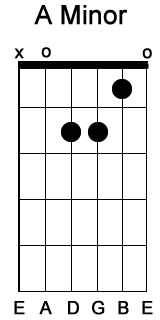
This half-step connection is the heart of the authentic (V-I) cadence. The same relationship happens in all major keys when you go from the V chord to the I chord. Listen to this example where I play the major scale pausing on the leading tone: If you play up the notes of a major scale and pause on the leading tone, you will notice the tension of the leading tone wanting to resolve up a half-step to the tonic. The leading tone is so named because it leads a listener's ear to the tonic. For example, in the key of C major (C, D, E, F, G, A, B, C) the leading tone is B and the tonic is C. In every major key, the leading tone-the seventh note-is always a half-step below the tonic, or first note, of the key. “Tonic” is another name for the first note of the scale. The “leading tone” is another name for the seventh of the scale. These two important notes are called the leading tone and the tonic. The satisfying resolution comes from two important notes inside of the V and I chords which are a half-step apart and smoothly connect from one to the next. What is it that creates tension in the V chord which pleasingly resolves to the I chord? A cadence is a harmonic or melodic structure at the end of a phrase or section of music.
A MINOR CHORD FULL
In music theory this V-I progression is known as an authentic cadence or full cadence. The tension of the dominant V chord resolves to the tonic I chord. Music's strongest harmonic movement is found in major keys where the V chord moves to the I chord. Then, I will explain how the same sound is often applied in minor keys. First, we will review how V chords work in major keys. Let's look at what happens in this special situation. In minor keys, however, there is a frequent harmonic “adjustment” made where the minor v chord of the natural minor scale is changed into a major triad or dominant 7th chord. The notes in these chords all come from the A natural minor scale. For example, in the key of A Minor the chord built on the fifth of the scale is an Em (E G B) or Em7 (E G B D). The v chord, when derived from the notes of the natural minor scale, falls as a minor triad or minor 7th chord. Minor keys revolve around the natural minor scale. I don't think there are any hard and fast rules about when to adjust things on the second, fourth, and fifth scale degrees, but doing so can be an essential part of making a major piece "sound" minor.In minor keys, there is more to understand about the v chord. The original melody on the downbeats (filtering out the Gs on the upbeats) is F F e d which includes a major seventh jump in minor, that becomes a diminished seventh jump. Changing the F's to F# ( raising them) creates tension and-at least to my ear-greatly improves things. d, which is harmonized over a V7 chord and thus wouldn't be recognizable as minor until the fifth note. A later section, however, goes G F, G F, G e. e e, which will instantly sound minor if the E is changed to Eb. For example, assuming a key of C, the Blue Danube Waltz starts out very nicely with C C E G G.

In such cases, it may be necessary to make additional melodic adjustments. If earlier and later parts of the melody have a lot of E's (which would be changed to E flat), having a portion which sounds just like the major version can seem weird. For example, if a piece is in C major and part of the melody only uses C, D, F, and G, that part of the melody will be completely unaffected by a change from major to minor. While a piece of music in a major key can be changed to a minor key merely by lowering the third, sixth, and sometimes seventh scale degrees, there will often be places in the melody where this doesn't have the desired effect. This is how most of these videos are done, as a far as I can tell, and is especially noticeable when listening to, say the mario theme song in a minor key when you have the sheet music and knowledge of what the Bb to D (major 3rd) interval sounds like vs the Bb to Db (minor 3rd) interval sounds like. This means that you wouldn’t lower the 7th.Īs he also pointed out, the harmonies have to change, but (correct me if I’m wrong) this should be handled by the fact that we are changing the scale degrees. The song you showed goes into a harmonic minor, as Tim rightly pointed out. In short, you are converting the scale they used into its parallel minor. To get the full transformation, you would need to lower every 6th and 7th scale degree too, if you are converting to the natural minor.

You would need to lower every instance of the 3rd Scale degree, to turn it into a minor 3rd.
A MINOR CHORD SOFTWARE
Going from major to minor is a bit more difficult, although there are pieces of software that can do it. You can easily change the key of a song by transposing it.


 0 kommentar(er)
0 kommentar(er)
